| Author | Message | |||
Jayvee |
Could anybody explain (for us "dummies", or maybe I'm the only one) what does this mean: "That billet piece has too short a grip length" Is that the bottom part where the bolt goes through it into the head? How do the people who run this mount bolt it if it's "too short" ? It looked like a good design, per the previous discussion, I was leaning toward this one as a 'someday' thing. | |||
Xldevil |
Dan. You've got mail. Ralph | |||
Xldevil |
Is that the bottom part where the bolt goes through it into the head? Hey. These bottom parts,where the bolts go through, have pretty much the same thickness as the the stock bracket. Also the bolts that came with the B2R bracket have the same length,compared to the stock bolts. Ralph | |||
Blake |
Grip length refers to how much of the bolt length is between bolt head and closest point of threaded engagement, so in this case, the depth of the bracket's bolt hole (thickness of bracket at bolt hole) plus the thickness of the washer as applicable. | |||
Court |
I can't help much on these siaze bolts, but if you get to BIG bolts. . . gimme a call, I have a pretty comprehensive library of tech data. Here's a pic that'll keep you from having to draw diagrams to illustrate the concepts of grip, "stick-thru", etc. 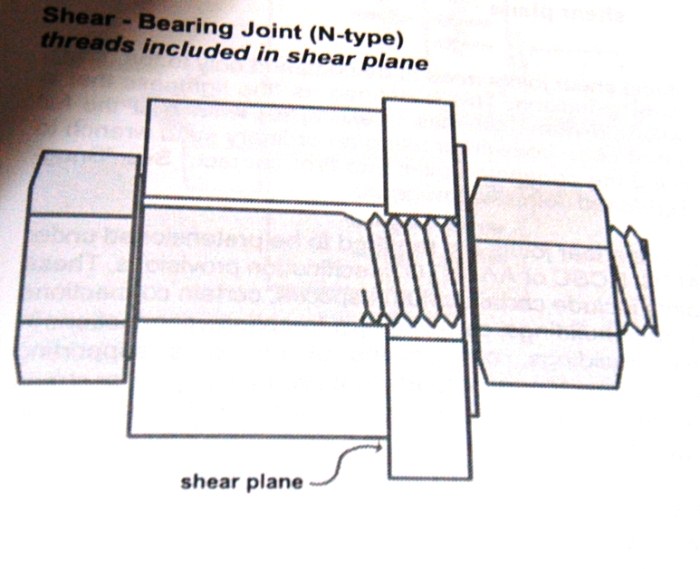 | |||
Al_lighton |
Maybe B2R changed the design. I bought one, and returned it to him after making the measurements and determining that the stock F911 bolts would not fit with his mount. At that time, he didn't have any intention of changing the design based on my comments about grip length and bolt strength, maybe that has changed. But he graciously returned my money. I've thought it odd that the Buell design doesn't have the unthreaded shank going past the shear plane. I've broken three of these bolts, and every one occurred within 1/2 thread of the shear plane. I'm pretty good at getting these broken bolts out, though  Al | |||
Blake |
Removing the threads from the shear plane improves the bolt shear strength by more than 40%, which is why you won't see any structural fasteners on aircraft with threads in the shear plane. Tough to get the threads out of the shear plane for a tapped hole though.  Is it feasible to do a close fit counterbore so that the smooth shank of the bolt would bear against the counterbore in the cyl head boss? It's a tricky joint for sure. There's a lot more to it that one might realize at first glance. I bet there was a good bit of engineering that went into it. I best like the idea of taking the bolt out of the shear load path entirely. I wonder if there is such a thing as a spike plate that would mechanically join the bracket to the cylinder head as during initial torquing. I'm thinking of a hardened steel washer that has small spikes on each face so that as the joint is torqued, the spikes embed into the softer aluminum and provide a robust load path for transfering shear at that joint. It would avoid the expense of machining the bracket and cylinder head for a more conventional mechanical engagement scenario. Interesting stuff. What is the XB bracket to cylinder head bolted joint like? Is it pretty much the same? | |||
Dck996 |
There are a couple of hardened washers with "spikey" features on the attached page from McMaster-Carr.
My S3 hasn't had this problem (knock on wood), but I not very keen on having the bolt threads under shear load. | |||
Rocketman |
Well I went to Scott's yesterday (again)and bought the only other option available. Interestingly, the knowledgeable sales fella had not heard of an L9 bolt. 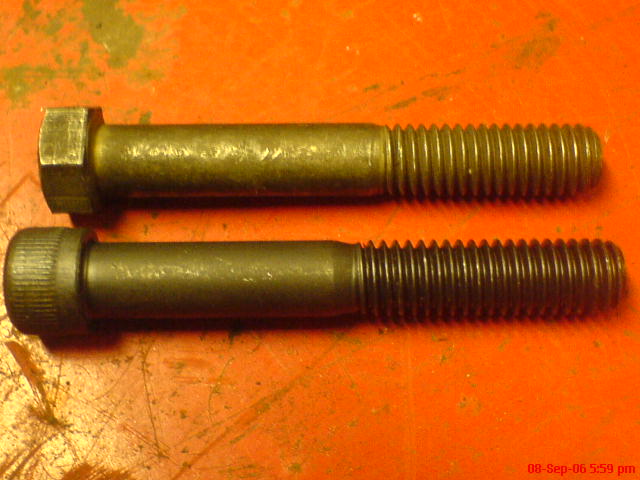 The cap screw comes in at 12.9 ISO, but as can be seen in the pic sat next to the 8.8 ISO bolt, which is about the nearest to optimum for thread and shank length, the cap screw if used will place the thread in the shear plane. What are our fine engineers opinions on this given it's a 12.9 bolt? I'm going to order the originals from Buell next week, if for no other reason, just to have a comparison to draw conclusions from. Is this going to be an L9 bolt, and will they have a rolled thread? By the way, what exactly is a rolled thread? Is it cast when the bolt \ screw is? Help?? Rocket (Message edited by rocketman on September 08, 2006) | |||
Rocketman |
Just for you Blake, here's a void bush.  Rocket | |||
Bomber |
Thread Rolling process is used for making external threads. A die, which is a hardened tool with the thread profile, is pressed on to a rotating workpiece. As the force is gradually increased, the thread profile is transferred to the workpiece. This process produces screws with greater strength than machined threads due to the cold working, as well as better material yield. 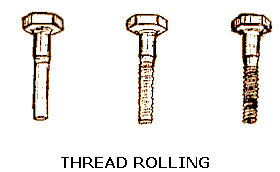 | |||
Rocketman |
Just for you Blake, here's a void bush. 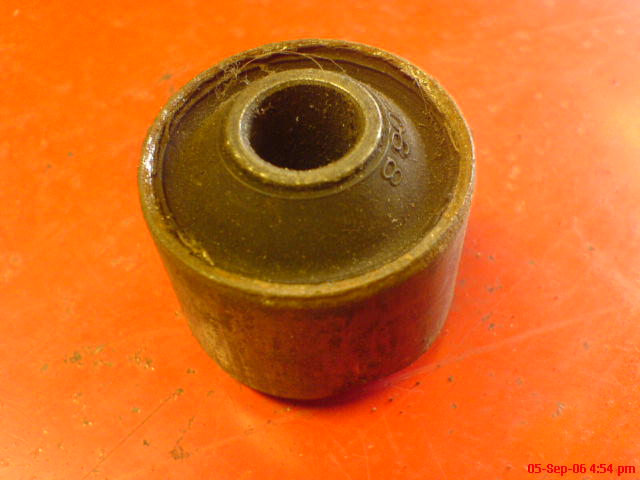 Imagine a bush small enough in o.d to fit within a nice styled billet front mount. What would be the usefulness of a void bush in this application given the bolt diameter remains the same and the mounting bracket accommodates a suitable width bush and length bolt? Rocket | |||
Rocketman |
Thanks Bomber. So basically, a thread is cut into a steel blank bolt by rotating the die around the blank under pressure whilst the blank bolt is cold? Maybe I'm not reading you right? Rocket | |||
Blake |
Isn't that basically what an isolator is already? What Bomber said re rolled threads. A diagram may help. It's the difference between forging and machining. One cuts the grain of the metal one forms it leaving it continuous and intact. Plus the thread rolling imparts residual compressive stresses in the surface of the bolt threads. Residual compression on the surface of a metal part helps resist fatigue (crack initiation/growth) failure. 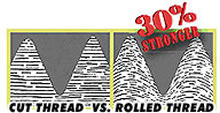 Section view of machined versus rolled thread showing granular structure at/near bolt thread surface These diagrams indicate rolled threads superior strength and resistance to stripping. A rolled thread grain structure is not severed in any way. It is instead, cold worked in unbroken lines that follow the contour of the thread. Therefore, for a shear failure to take place it must occur across, rather than with the grain. I took the above from http://www.rolledthreads.com/why_rolled_threads.htm | |||
Bomber |
I'm tinkin that even ROLLED threads create quite a stress riser when the threads in are shear -- while they may present greater resistance to stripping, I'm not clear on whether they'd give (much) greater shear strength I'll add that to the things I don't know! | |||
Rocketman |
Isolator, well maybe. I dunno what the tech spec / difference is, if there is one. I did mention language barrier when I first mentioned void bush. That said, I think void bush might not exactly be what I've shown. Sorry if that's confusing but my experience tells me different auto manufacturers call things different to one another. The bush in the pic for instance, looks like the bush in the working diagram on the web site I pointed you to. Rear axle void bushes in British Ford application have hollowed out spaces in the rubber section for movement. Saab use a similar hollowed bush in their top engine mounting stay on the 9000 range, but Saab don't call it a void bush. Anyway, let's get back on track. So what do you guys think of using the 12.9 ISO cap screw with the thread in the shear plane? What about the L9 bolt. Is that what Buell supply as their oem fitting? Now maybe I'm stupid but I can't picture the machine that makes a rolled thread. I need to understand the workings of such, but I did like the 'grain' thing, which I now understand. Rocket | |||
Bomber |
think about a standard thread cutting die now turn it inside out, with it's lil teethers on the outside hold it up to the bolt-to-be, and rotate both while pushing em together, hard | |||
Court |
>>>One cuts the grain of the metal one forms it leaving it continuous and intact. Essentially the verbatim definition of "cut" and "rolled" threads. All the big bolts I've used over the years, like 2-1/2", have always been rolled. | |||
Blake |
There are flat faced die thread rolling machines too. Sean, if you google "thread rolling" you'll find a lot of info and pics showing how its done. Not sure if shear stress cares about stress risers, that's more of a tension stress issue. But if you look at the root of a rolled thread under a microscope versus a the root of a cut thread, you'll easily see why one is stronger than the other.  | |||
Bobpaul |
Rocket, Flat rolling is the same as when you roll clay in your hands. The palms of your hands rub together and the clay is in beween and rolls into a cylinder. Same idea only the thread forms are on the palms of your hands. Bolt yield strength Gr8 & ISO 10.9 130 ksi ISO 12.9 156 ksi SPS-Unbrako SHCS 170 ksi L9 bolts 180 ksi I though all commercial bolts under about 1.5" all have rolled threads? It's my understanding that all Imperial threaded bolts that have socket (allen) heads are made to Gr8 spec or better. Rocket, you'll have to ask your bolt supplier what strength he selling you. I'm still curious about the torque. SPS-Unbrako says 100 ft-lb, my manual says 73-78 ft-lb and Al has quoted 60 ft-lb from SB-018. Seems nuts to be torquing to high values into soft (and dodgy alloy) aluminum. XLdevil, Looks like the "Stenzel Stütze" solution is the best one. I bet I can use regular old GR8 bolts. Where can I get one of these? I sent an email to the link you posted (ok, it was in English intstead of German) but I didn't get any reply at all! thanks! | |||
Blake |
The 180 ksi for an L9 bolt is not yield strength; it is ultimate tensile strength, which compares to 150 ksi for an ASTM Grade-8 bolt. | |||
Rocketman |
The cap screw is rated at 12.9 ISO. Rocket | |||
Xldevil |
Bobpaul: You can not expect such a fast reply from a german dealer.You're really pampered by your american dealers. It takes time and sometimes they don't answer at all.You have to try it more than once.Or call Stenzel. Most of german dealers are not very customer-friendly.That is one of the main reasons why I prefer to order my Buell parts in the US. Ralph | |||
Djkaplan |
"Looks like the "Stenzel Stütze" solution is the best one." It certainly is interesting. I can see how it would help keep lateral load off the front mount. If I can't buy one from Stenzel, it looks easily fabricated. The idea is simple, but really good. Return my e-mail Stenzel! | |||
Bobpaul |
hey guys, I got an email back from Stenzel. The support is $106 delivered to your USA door (65 + 41 shipping), but he is offering us a great deal. If we order 10 units sent to one USA address they are just $59. Of course we'd have to ship from that location to your house. Or, if they get shipped to me, you can "pop over" and pick it up.  . . Anyone interested? here's the SPS Unbrako web page where you can download the engineering guide. http://www.unbrako.com/Engineer_guide.htm here is the Bossard web page to all kinds of interesting tables. Look at the mechanical properties table for yield strengths. Also there are tables to convert from Imperial to SI units. http://www.bossard.com/techinfo/en/index.html | |||
Xldevil |
Hey. $41 shipping for a part that weighs less than 500 grams? Sounds very pricey to me. You can get it shipped from Germany to anywhere in the US by DHL for only 12.90 euros or 17 dollars. This is called "Päckchen International" and goes up to 2000grams. http://www.dhl.de/dhl?tab=1&skin=hi&check=yes&lang=de_DE&xmlFile=11440 Tell Stenzel that he should take DHL to send them parts. Ralph (Message edited by xldevil on September 11, 2006) | |||
Stenzel |
Hi The Ship Cost of 41$ are with inshurence,(DHL 0-5kg) http://www.dhl.de/dhl?tab=1&skin=hi&check=yes&lang=de_DE&xmlFile=3001057 www.stenzel-parts.de Regards Stenzel | |||
Bobpaul |
Rocket, Did you get your bolts sorted? | |||
Rocketman |
Yes I did thanks. To cut a long story short I fitted the upgrade Buell bolts yesterday afternoon. I'm really busy at the moment but will post more on this a little later. Thanks, Rocket | |||
Rocketman |
Ok, time I finished this off. 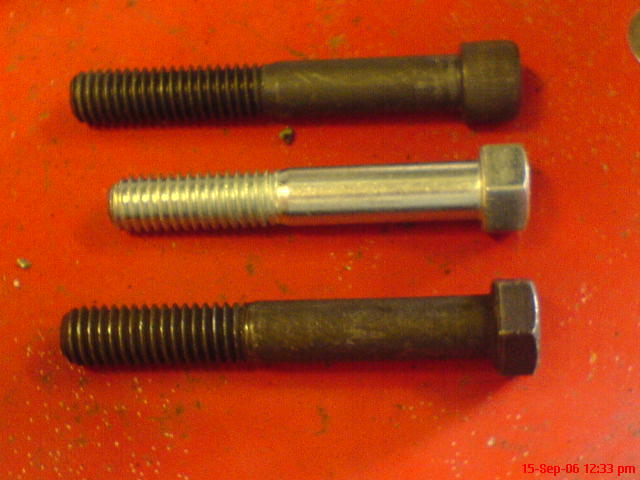 The 8.8 ISO bolt (BOTTOM IN PICTURE) is not an optimum shank length, though the thread length is close to the stock bolt, but because the shank is too long a spacer is required. Then when you've got that sorted the bolt strength is not up to the required standard recommended by Buell with their upgrade bolt. Might work in an emergency 'get out of jail' type scenario but not recommended for long term use. The 12.9 ISO strength comes in cap screw form only (TOP IN PICTURE). Then the thread is too long and therefore sits in the shear plane, along with the cap screw overall length also too long, spacing is required. I didn't use this set up in the end but I guess from a strength perspective it's perhaps more ideal than the 8.8 ISO option in the 'get out of jail' event. The Buell upgrade bolts are the way to go (MIDDLE IN PICTURE). The only downside is Buell are ripping off their customers charging nearly £8 for a bolt that cost less than half that from other sources. The recommended upgrade bolt Buell supply is known as an F9 11 specification. Where a 12.9 ISO bolt comes in it 180.000KSI an F9 is rated at 190.000KSI, so wins in the strength stakes. Obviously it is the correct length and importantly the washer that matches the F9 bolt is designed so as the torque load can be achieved accurately because the underside of the bolt head is designed to contact the washer perfectly. The rule here is when replacing the bolts make certain the washers are used too. In the other two applications the washers DO NOT seat correctly with the underside of the bolt or cap screw head and will lead to incorrect torque values. Rocket |